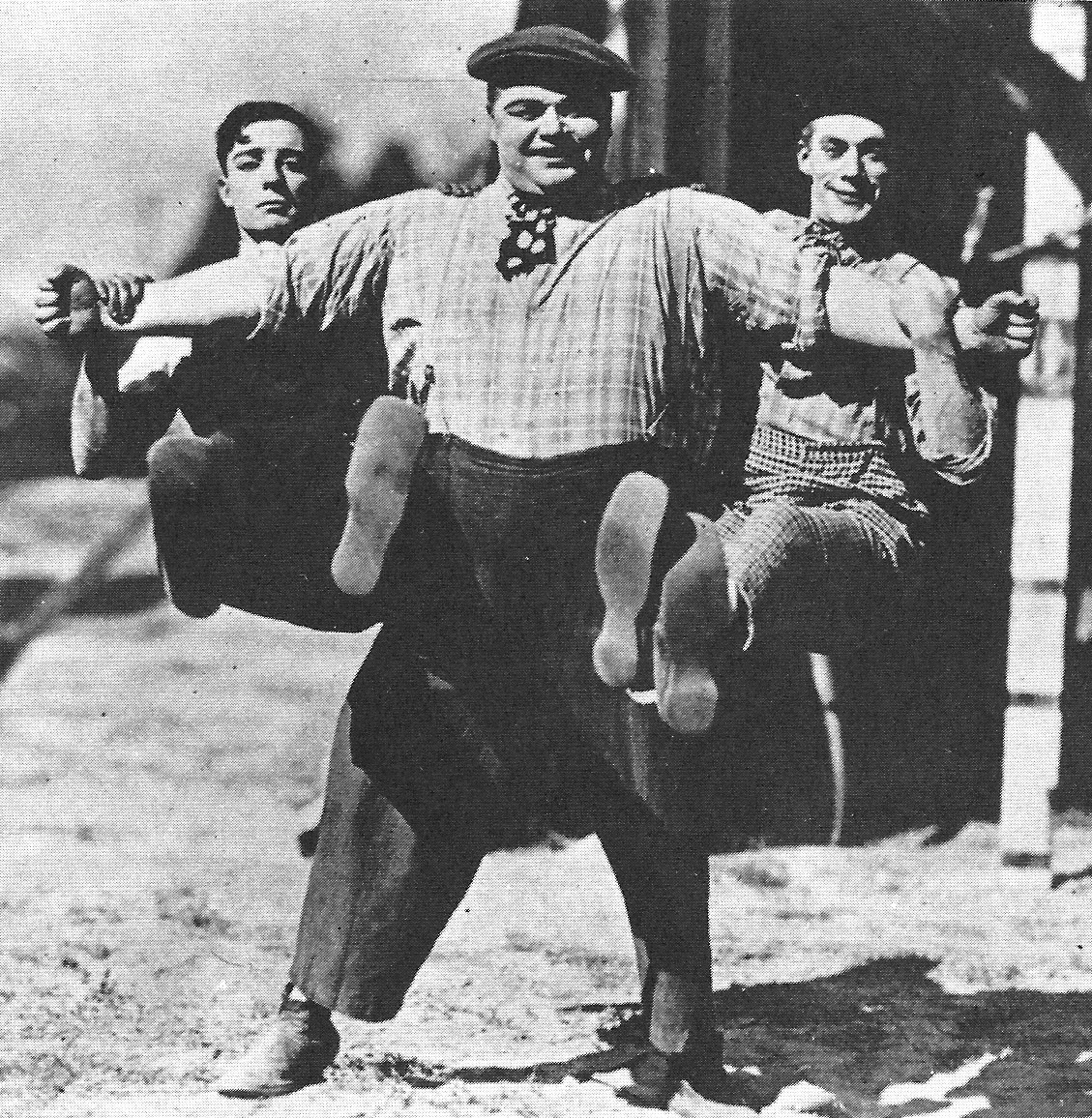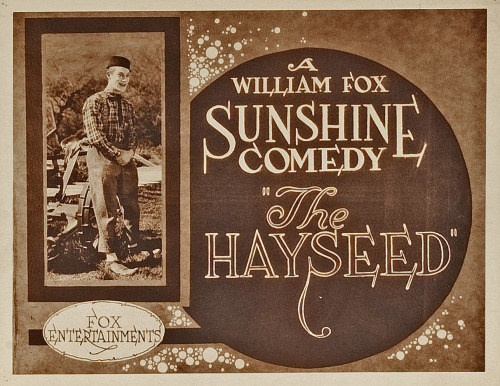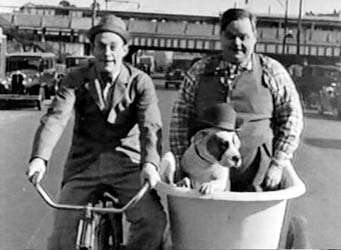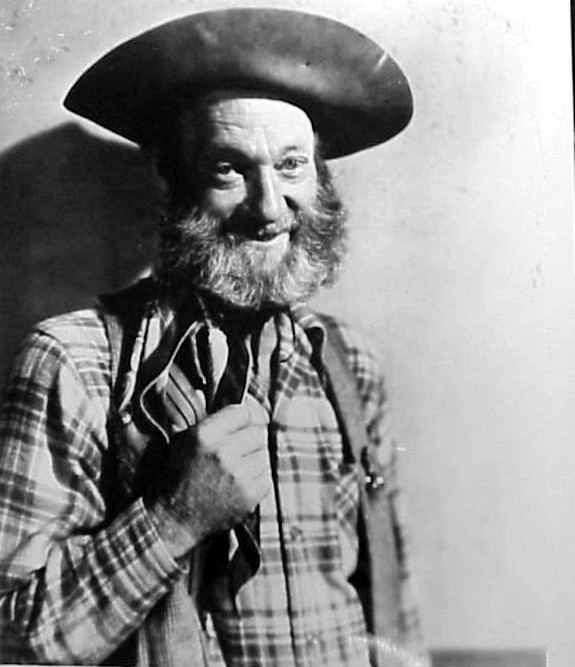Have you ever had an actor who grew on you? Someone you really didn’t care for at first, but who finally won you over? For me, it was a comedian you may or may not have heard of: Al St. John, nephew of Roscoe “Fatty” Arbuckle and a key player at the legendary Keystone Film Company.
Why didn’t I care for him? Well…

Let’s just say he was a little much. But only at first! …Let’s take a look.
The son of Walter and Nora St. John, Al was born in Santa Ana on September 10, 1892. Nora was the older sister of Roscoe Arbuckle, making him Al’s uncle, although they were only a few years apart in age. Al was apparently a high-energy boy who had little interest in school, and lots of interest in show business. A natural tumbler who never minded risking life and limb, he discovered a knack for doing bicycle tricks, performing them for a local theater when he was in his teens. These tricks, done with an ease that made the bike seem like an extension of his wiry body, would be Al’s trademark throughout much of his career.
Al’s parents were less than thrilled about their lively son’s ambitions, especially Walter, who was a pragmatic laborer. It didn’t help that Roscoe and his wife Minta Durfee were vaudeville performers (and perhaps had helped Al find work on the stage). But when Roscoe broke into the motion picture business, becoming a popular player at Mack Sennett’s Keystone Film Company in 1913, it wouldn’t be long before Al hopped over there too.
The story goes that Roscoe had promised Al’s parents to keep him away from Keystone (anything but working in those “flickers”!). However, Al and Minta put their heads together and arranged for Al to just happen to be doing bike stunts when Sennett was nearby. Impressed by the young man’s skills, Sennett hired him for $3.00 a day.

With Alice Howell in Shot in the Excitement (1914).
Al threw himself into the job, playing bit parts in dozens of shorts. In the Keystone world, replete with parks, cheap hotels, farmhouses, and saloons, Al might turn up as everything from a bellboy to a waiter to a farmhand–you could make a game out of guessing when he’d show up next. He also frequently played a Keystone Kop–he appears prominently in Keystone’s most famous still.

Smack dab in the middle.
That willingness to risk life and limb also came in handy. Diving, tumbling, racing across rooftops, getting hit in the head with fake bricks–Al did a bit of everything, and was especially keen on automobile stunts. He apparently masterminded the chase scenes where cars spun on the pavements by removing a few brakes and soaping up the street (hopefully it was hosed down afterwards.) Legend has it that he once challenged the famed race car driver Barney Oldfield to a race, likely around the time Oldfield made an appearance in a Keystone film (Al did lose, but just barely).
At a studio swimming with uninhibited performers like Ford Sterling and Rube Miller, Al became one of the most gleefully over-the-top, especially once he had larger roles in the shorts Roscoe directed. Mugging, hopping and pratfalling like a living cartoon, his bug-eyed performance style was broad, to say the least.

As shown in The Waiter’s Ball (1916).
He also adopted a signature “bumpkin” costume of slapshoes, checkered pants, a plaid shirt and a small, brimless hat (sometimes accented with blacked-out teeth). He would often play Roscoe’s hotheaded rival, leading inevitably to brick-throwing battles or Al getting thrown across the room. A memorable appearance was as the villain in the classic Fatty and Mabel Adrift (1916), the kind of role that would lead historians to dub him a kind of slapstick “gremlin.”

When Roscoe left Sennett in 1916 to direct his own comedy shorts in New York City (his studio was dubbed the Comique Film Corporation), Al came along, likely excited to experience the fun and freedom of working on a more independent series. It started out strong with the addition of young vaudevillian Buster Keaton, who had been invited to tour Comique. Roscoe and Al were familiar with Buster’s work from vaudeville and invited him to play a scene with them in The Butcher Boy (1917). Buster did, became hooked, and began his iconic career in films.

Al, Roscoe and Buster were a kind of comedy trio–a rare thing in the silent era–and arguably one of the very best. Buster fit beautifully into Comique’s high-energy, freewheeling atmosphere, and his formidable pratfalling skills complemented Al’s and provided him with some worthy competition. Their scenes together also freed up Roscoe to concentrate on his solo scenes, keeping him established as the main star. The result were such classics as The Rough House (1917), Moonshine (1918) and The Bell Boy (1918). Offscreen the three also spent time together at Hollywood nightlife spots, planned out elaborate pranks and put on the occasional charity baseball game (where the highlight was usually a plaster-of-paris baseball that exploded on impact).

Towards the end of the popular series, shortly before Roscoe decided to go into features and hand the reins of Comique over to Buster, it was announced that Al would be striking out on his own. He starred in comedies for Paramount and Fox, similar in style to the Comiques with playful gags and plenty of energy, and also made a cameo in Buster’s first solo film, The High Sign (1919) (although it was shelved for a time). He used the “rube” character he had refined throughout the late 1910s, now portrayed as more of a naive country youth than a vengeful gremlin, and his bicycle made regular appearances too.

His fearless acrobatics were a draw at the time. A 1920 article in Motion Picture Magazine claimed:
Al will try anything! He does not rehearse difficult feats. He simply takes his life in his hands. He has a lucky barnacle sort of clutch. I have seen him take a twenty-foot jump on a bicycle, hit a concrete balcony and dash right thru a window, without shaving an eyelash and as devil-may-care as you please…How he avoids breaking his neck is a mystery, but he manages to land on the side of his neck every time and he isn’t keen on having nets spread to catch him, either. It is only in very high jumps that he consents to be a “poor fish,” as he terms such cowardly acts.

Stunting for The Aero-Nut (1920).
Years later, Buster would also claim that Al happily risked life and limb…maybe a little too much. In his autobiography he said:
The ex-Keystone Cop, Al St. John…worked side by side with Roscoe for five years without learning one damn thing about protecting himself in a fall. As an old trip-and-tumble expert myself, I advised St. John to use elbow pads, something he had never heard of until then. He had been using his hand and elbows each time to break his falls. The result was that he was continually suffering from water on the elbow which, of course, was bound to have serious consequences sooner of later.
Motion Picture News, 1922.
While he was a successful comedian, the early 1920s would be difficult for Al. His beloved uncle Roscoe would go through the infamous Labor Day scandal of 1921–or as Buster put it, “the day our laughter stopped.” Arbuckle comedies were pulled from the screen, and Roscoe faced an uncertain future. In 1923, Al’s wife Lillian divorced him. They had been married since 1914 and had a daughter, Mary Jane. It was a rough divorce, with Lillian citing alcohol as one reason for the split, and she would constantly battle him over alimony and child support in the following years.
By the mid-1920s, Al had remarried to actress Yvonne June Villon. It would be a much happier union, lasting until her death in the 1950s. He and Buster would continue collaborating with Roscoe, who quietly directed a number of Al’s comedies such as the Wild West spoof Curses (1925) and The Iron Mule (1925), about an engineer whose train endures a series of obstacles–Buster loaned his old-timey train from Our Hospitality (1923) to the set.

As the public’s tastes began shifting away from wild slapstick, Al adopted a more nattily dressed “everyman” character and a less manic, more straight-faced style. Very straight-faced at times–some of his performances clearly take inspiration from his friend Buster. He also began taking small roles in features with stars like Eleanor Boardman and Lupe Velez.
In the early 1930s, enough time had passed for Roscoe to make a comeback and he began starring in Vitaphone shorts. Al would costar with him in Buzzin’ Around (1933) happy to support his uncle. But sadly, after only a few shorts Roscoe passed away from a heart attack in his sleep. Considering how close the two were, we can only imagine how heartbroken Al must’ve been by the news.

Buzzin’ Around, their last appearance together.
Largely turning away from two-reel comedies–never quite the same without Roscoe–Al did some stints in vaudeville and then found a niche in B movie Westerns. He began specializing in playing grizzled, comical sidekicks, usually called “Fuzzy Q. Jones” or “Fuzzy.” He had roles in a bewildering number of westerns with stars like Lash LaRue, Tom Tyler and Buster Crabbe. LaRue would recall him fondly:
Fuzzy was an angel unaware, as far as I’m concerned. He was a wonderful guy, and I wish he were still here to see how long the films had lasted … he was the greatest ad lib artist in the world. He could stumble over a matchstick and spend fifteen exciting minutes looking for what he stumbled over.

Buster Crabbe also had some touching memories:
He was a lot of fun on the set, and always willing to offer advice. The directors would rely on his background when they would stage a fight scene. He was terrific with the actors. The younger folks loved hearing his tales about working in the silent pictures. There was ore than one time when Al would talk about Fatty Arbuckle and would end up in tears. He would always compose himself and be ready to get back to work, but it was obvious that whole things still affected him.
In 1952, with nearly 400 film credits to his name, Al retired from the screen but continued making personal appearances at fairs, rodeos, and Wild West shows. He donated much of his earnings to the Muscular Dystrophy Association. During a 1963 tour with the Tommy Scott Wild West Show, he passed away from a heart attack in his hotel. He was survived by his third wife, Flo Bell Moore.

Being an ardent Buster Keaton fan and all, when I first sought out his appearances in the Arbuckle films I confess that the mugging, hopping Al St. John took some getting used to. But he became a familiar face, and I admitted that he could do some spectacular falls. In time, when he wasn’t onscreen I started wondering when he’d show up again. Then I started looking forward to seeing him. Slowly but steadily, I’d become a fan. Much like Buster, Roscoe, Laurel and Hardy, Harry Langdon, etc., he’s become a “pal.”

Since then, I’ve seen more of Al’s range and recognized his niche in classic comedy history. One of the most hardworking, modest performers in silent comedy, he very much embodied the most unpretentious side of Hollywoodland.

Sources:
Delvigne, Doris. “According to St. John.” Motion Picture Magazine, February 1920, page 45.
Keaton, Buster, with Samuels, Charles. My Wonderful World of Slapstick. New York: Doubleday & Co., 1960.
Lahue, Kalton C. and Gill, Sam. Crown Princes and Court Jesters: Some Great Comics of the Silent Screen. South Brunswick: A.S. Barnes and Co., Inc., 1970.
Neibaur, James L. Arbuckle and Keaton: Their 14 Film Collaborations. Jefferson, North Carolina: McFarland & Company, 2007.
Walker, Brent E. Mack Sennett’s Fun Factory. Jefferson, North Carolina: McFarland & Company, Inc., 2010.
http://www.b-westerns.com/pals-asj.htm
https://lantern.mediahist.org/
https://en.wikipedia.org/wiki/Al_St._John_filmography

Thanks Lea. He reminds me of Jon Hamm in appearance. His “glamor” headshot and later Fuzzy headshot side-by-side are unrecognizable.
You’d never know they were the same guy!
I loved Fuzzy…Have all of his western movies I could get my hands on….He was, by far, the best sidekick in westerns-nobody could touch him….My favorite westerns were Fuzzy with Buster Crabbe…Fuzzy was at his very best in
Mr. Crabbs movies…..
I feel exactly the same! I couldn’t stand him at first but he grew on me.
😀 It must be his special gift.
Very interesting. I feel the same way about Al. So over the top, I found him an annoying distraction at first but slowly warmed up to him to the point where I could admire those incredible physical feats so much that I’d back up and re-watch the scene!
There’s that one scene (From THE BELL BOY maybe?) where he does a flip with his back on the top of a chair, so he landed in a sitting position–if I tried that, I’d probably snap my spine in half. 😀
It IS from The Bell Boy, which we just watched for the umpteenth time (and laughed as hard as when we first saw it!).
During that sequence, I actually yelled, ‘Al! Watch yourself!’ 😜
😀
I cannot tell you how much I adored Al from the first moment I saw him (in Arbuckle’s Coney Island). His wild leaps, muggings, and ‘romance’ with Roscoe’s character who dressed as a girl…I nearly popped a rib, and this is soooo not my style of comedy! There was something about him that said to me, ‘Wheee! Let’s make friends and play!’
I didn’t know that a out the elbow pads. Thanks for another great article! 👍🏻
Well that’s wonderful! I’m sure Al would appreciate that you “got” his humor right away. Some of us take longer. 😀
Thank you for this wonderful article on “Fuzzy.” I knew him for years as the western sidekick and it was a while before I made the connection between that young fellow I watched in the old comedies. What a career! And what a lovely description of an angel unaware.
Can you imagine how many stories he must’ve had, after working on almost 400 films? Just remarkable. Very glad you enjoyed the article, my friend!
I adore Al. I’m not sure I remember what I thought of him at first, but if I ever wondered if he was worth my time, Bridge Wives sealed the deal. It is one of my very favorite shorts, and it was directed by Uncle Roscoe (as William Goodrich). I still remember the first time I saw it. Paul Gierucki intro’d it at our Keaton Convention in Muskegon by saying “Ladies and Gentlemen, Al St John loses his mind. Enjoy!” And I my goodness did we ever. We made him run it again.
Bridge Wives is a classic! I can totally see how you’d become a fan through that short. What a great audience to enjoy it with, too. (I’ve been to the BK convention once and it’s one of the loveliest weekends I’ve ever experienced.)
All that knockabout slapstick took its toll on him, and you can see the evidence as early as 1930, when he begins popping up in B-westerns: even that early, he doesn’t have any teeth left!
I know he had issues with drinking as well, although he was always bright-eyed and professional on the set.
Al St John was great. A truly fearless stunt man and actually a very skilled physical comedian. About the blackening of his teeth: I actually think he already lost most half of his upper left teeth quite early on. Notice that he never smiled in photos exposing that part of his mouth. He possibly lost most early on because of his stuntwork or he might have bad teeth to begin with. Dental care was not that commonly available to most people then. Anyway it gives him an even more crazed appearance. I love this guy!
Yes, it looks like he lost 1-2 teeth on the side of his mouth at some point for sure. He probably had a story behind how they got knocked out!
I’m always flattered when you quote from my books among your sources (I recognized the Buster Crabbe quote — he was a friend). I think it is the too-much-ness that initially attracted me to Al. He was so exuberant and over the top, and his stunt work was pure slapstick craziness. Thanks for writing the best article I’ve ever read about him.
Your book on the Comiques is essential reading, if you ask me! Always happy to use it–and any of your other books–as a source. 🙂 So glad you liked the piece, it was about time I gave Al some attention!
We’re reading it now.
Pingback: (From one of my favorite blogs, about one of my favorite silent comedians):The Lively Al St. John: An Appreciation — Silent-ology | Cinematica
Unfortunately for Al his “psycho-rube” appearances are what most today think of him. The supporting terror of Keystone. But Al had a significant career as a two-reel star for all of the 1920’s long after he abandoned his “psycho-rube” persona, that is largely forgotten due to loss of material.. By my count 35 shorts for Fox and 29 shorts for Educational. That’s nothing to sneeze at, all for major studios. Not many of his contemporaries starred in more shorts.
I remember a rumor went around that Roscoe Arbuckle actually directed the shorts that Al was credited as director at Fox. I took to this rumor but then Al’s greatest defender Anniken remonstrated me by saying that Al was in so many comedies before his Fox stint, why couldn’t Al be competent enough to be a good comedy director as many of Al’s contemporaries were. Anniken convinced me she was right on that subject.
Lots of great stills here!
Al certainly directed many of the shorts he appeared in, he definitely knew his way around a film studio. We do know Roscoe directed at least a few–probably not the Fox shorts in particular, I think those were made when Roscoe was in features and during the aftermath of the Labor Day scandal. But it makes sense that Al would provide Roscoe with “behind the scenes” work.
Unfortunately for Al his “psycho-rube” appearances are what most today think of him. The supporting terror of Keystone (sharpening knives on his shoe soles). But Al had a significant career as a two-reel star for all of the 1920’s long after he abandoned his “psycho-rube” persona, that is largely forgotten due to loss of material. By my count 35 shorts for Fox and 29 shorts for Educational. That’s nothing to sneeze at, all for major studios. Not many of his contemporaries starred in more shorts.
I remember a rumor went around that Roscoe Arbuckle actually directed the shorts that Al was credited as director at Fox. I took to this rumor but then Al’s greatest defender Anniken remonstrated me by saying that Al was in so many comedies before his Fox stint, why couldn’t Al be competent enough to be a good comedy director as many of Al’s contemporaries were? Anniken convinced me she was right on that subject.
Lots of great stills here!
I forgot to mention this. Lea, have you seen CROSSED LOVE AND SWORDS with Al and Louise Fazenda? Both were definitely out of character for this Keystone comedy.
Yup, I have! It was probably a fun challenge to have some “out of the norm” Keystone roles once in awhile.
Loved Al St. John the instant I first saw him. I was amazed he wasn’t as well known — so charming and goofy — and so talented! …Rowby Goren.
Much agreed, Rowby!
Pingback: Alice Howell, The Plucky “Scream Of The Screen” | Silent-ology
Pingback: Lige Conley, The Bit-Of-Everything Comedian | Silent-ology